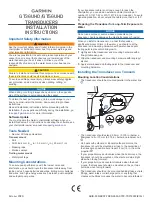
CC1000
SWRS048A Page 35 of 55
24. Crystal oscillator
CC1000
has an advanced amplitude
regulated crystal oscillator. A high current
is used to start up the oscillations. When
the amplitude builds up, the current is
reduced to what is necessary to maintain
a 600 mVpp amplitude. This ensures a
fast start-up, keeps the current
consumption as well as the drive level to a
minimum and makes the oscillator
insensitive to ESR variations.
An external clock signal or the internal
crystal oscillator can be used as main
frequency reference. An external clock
signal should be connected to XOSC_Q1,
while XOSC_Q2 should be left open. The
XOSC_BYPASS
bit in the
FRONT_END
register should be set when an external
clock signal is used.
The crystal frequency should be in the
range 3-4, 6-8 or 9-16 MHz. Because the
crystal frequency is used as reference for
the data rate (as well as other internal
functions), the following frequencies are
recommended: 3.6864, 7.3728, 11.0592
or 14.7456 MHz. These frequencies will
give accurate data rates. The crystal
frequency range is selected by
XOSC_FREQ1:0
in the
MODEM0
register.
To operate in synchronous mode at data
rates different from the standards at 1.2,
2.4, 4.8 kBaud and so on, the crystal
frequency can be scaled. The data rate
(DR) will change proportionally to the new
crystal frequency (f). To calculate the new
crystal frequency:
DR
DR
f
f
new
xtal
new
xtal
=
_
Using the internal crystal oscillator, the
crystal must be connected between
XOSC_Q1 and XOSC_Q2. The oscillator
is designed for parallel mode operation of
the crystal. In addition loading capacitors
(C171 and C181) for the crystal are
required. The loading capacitor values
depend on the total load capacitance, C
L
,
specified for the crystal. The total load
capacitance seen between the crystal
terminals should equal C
L
for the crystal to
oscillate at the specified frequency.
parasitic
L
C
C
C
C
+
+
=
181
171
1
1
1
The parasitic capacitance is constituted by
pin input capacitance and PCB stray
capacitance. Typically the total parasitic
capacitance is 8 pF. A trimming capacitor
may be placed across C171 for initial
tuning if necessary.
The crystal oscillator circuit is shown in
Figure 24. Typical component values for
different values of C
L
12.
The initial tolerance, temperature drift,
ageing and load pulling should be carefully
specified in order to meet the required
frequency accuracy in a certain
application. By specifying the
total
expected frequency accuracy in
SmartRF
®
Studio together with data rate
and frequency separation, the software
will calculate the total bandwidth and
compare to the available IF bandwidth.
C171
C181
XTAL
XOSC_Q1
XOSC_Q2
C171
C181
XTAL
XTAL
XOSC_Q1
XOSC_Q2
Figure 24. Crystal oscillator circuit
Item
C
L
= 12 pF
C
L
= 16 pF
C
L
= 22 pF
C171
6.8 pF
18 pF
33 pF
C181
6.8 pF
18 pF
33 pF
Table 12. Crystal oscillator component values
















































